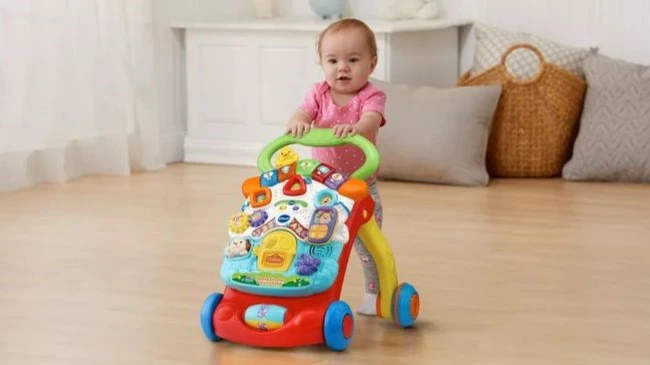A baby’s first steps are one of life’s most unforgettable moments! There’s something magical about seeing those tiny feet waddle forward, full of determination and excitement.
Did you know that most babies take their first steps between 9 to 15 months? That means if your little one isn’t there yet, they’re still well within the normal range!
Every child develops at their own pace. Some start walking early, while others take their time. Instead of stressing, let’s focus on creating a fun and encouraging environment to help your baby gain confidence and strengthen their little legs.
In this guide, I’ll share practical tips, personal experiences, and expert-backed advice on how to encourage baby to walk. From simple exercises to the right footwear, I’ve got you covered. Let’s get that baby moving!
Understanding the Walking Milestones
Babies don’t just wake up one day and start walking. It’s a process that begins long before that first step.
Here’s how it typically unfolds:
- Rolling Over (3-6 months): Strengthens core muscles, which are essential for walking.
- Sitting Up (6-8 months): Helps babies gain balance.
- Crawling (7-10 months): Improves coordination and leg strength.
- Pulling Up (9-12 months): A sign your baby is getting ready to stand independently.
- Cruising (10-13 months): Walking while holding onto furniture, gaining confidence.
- First Independent Steps (9-15 months): The big moment!
- Confident Walking (12-18 months): Moving without assistance and exploring different surfaces.
If your baby is still crawling and hasn’t shown much interest in walking, don’t stress. Some babies skip crawling entirely and jump straight to standing and walking.
Remember: Every baby moves at their own pace!
Best Ways to Encourage Baby to Walk
1. Create a Safe and Supportive Environment
Babies need space to explore. Clear the floors, remove sharp-edged furniture, and set up a baby-proofed area with soft carpets or play mats.
A well-set-up space does wonders for your baby’s confidence. I remember when my cousin’s little one started walking—she was hesitant at first, but once they cleared the living room and put down some soft mats, she was off like a rocket!
The safer they feel, the more willing they’ll be to move! Adding baby gates can help create a dedicated walking area where they can practice safely.
As child development expert Dr. Jane Scott says, ‘Babies learn best in a safe environment where they feel secure enough to explore.’
Now that you’ve set up the perfect space, here’s what’s next…
2. Encourage Standing and Cruising
Helping your baby stand up is a big step toward independent walking!
If you’re wondering how to encourage baby to stand, start by giving them plenty of opportunities to practice pulling up on stable furniture. Strong legs lead to strong steps!
Start by placing them near a sturdy couch or table where they can hold on and pull themselves up. This is a key part of how to encourage baby to walk because it builds their leg strength and balance. This gives them the confidence to balance on their feet.
Once they are comfortable standing, place a favorite toy just out of reach to encourage them to move along the furniture—this is called “cruising,” and it’s a fantastic way to improve balance and strength.
Mistake to Avoid:
Don’t rush your baby into walking independently before they’re ready. If they struggle to stand or move along furniture, let them practice at their own pace. Pressuring them too soon can lead to frustration or even fear of walking.
But don’t worry—this is completely normal! Many babies need a little extra time to feel confident on their feet.
The key is to stay patient and offer gentle encouragement. With the right support, they’ll get there in their own time!

3. Use Walking Toys and Push Walkers
Push walkers (not the wheeled sit-in type) help babies build confidence while practicing their steps.
If you’re wondering how to encourage baby to walk, providing them with a stable push walker can be a fun and effective way to get them moving. They provide stability and allow little ones to push forward at their own pace.
Research suggests that push toys promote better muscle development than traditional walkers, which can sometimes hinder a baby’s natural gait.
I remember when my friend’s son was struggling to take those first independent steps. They introduced a sturdy wooden push cart, and within days, he was zipping across the room, laughing with excitement! The push walker gave him just the right amount of support to feel secure while still allowing him to control his movements.
Mistake to Avoid:
Avoid relying too much on push walkers. While they can be helpful, using them excessively may take away from natural walking practice, which is essential in how to encourage baby to walk. While they are a great tool, they shouldn’t replace natural movement like standing, cruising, and balancing. Babies still need plenty of time walking unassisted to develop their muscles properly.
So, what’s the next step? Let’s talk about strengthening those tiny legs!

4. Practice Balance and Coordination Games
Games like “sit-to-stand” (where you gently hold their hands and let them rise to a standing position) help with leg strength. Dancing to music also builds coordination!
Another great game is rolling a ball back and forth while they are in a standing position—it helps with balance and control.
Movement-based games help babies associate walking with fun, making them more likely to try it on their own.
As child development specialist Dr. Emily Roberts says, ‘Play is the best teacher—when babies engage in movement games, they build muscle memory and confidence naturally.’
Mistake to Avoid:
Avoid using activities that are too advanced too soon. If your baby struggles with balance, start with smaller movements like supported standing before introducing more complex games. Trying to rush the process can lead to frustration.
And here’s the best part—these activities don’t just help with walking, they also make for some really fun bonding moments!

5. Offer Positive Reinforcement & Praise
Encouragement goes a long way when helping your baby walk!
Cheering and clapping every time they take a step boosts their confidence and motivates them to keep trying.
A simple, enthusiastic “Yay! You did it!” can make a huge difference. Offering small rewards, like an extra hug, a high-five, or playtime with their favorite toy, helps reinforce their efforts and makes walking a fun experience.
As child psychologist Dr. Lisa Carter explains, ‘Babies thrive on positive reinforcement. When they see your excitement, it reassures them that they’re on the right track and builds their confidence to take more steps.’
Mistake to Avoid:
Avoid pressuring or overreacting when your baby stumbles. If they sense frustration, they may become hesitant to try again. Keep your reactions lighthearted and encouraging, so they feel safe exploring movement at their own pace.
And remember—each tiny step is a big victory for them! Keep cheering them on, and soon they’ll be walking like a pro.
For tips on keeping your cool and staying supportive, check out this expert advice on having patience with a toddler. Keep your reactions lighthearted and encouraging, so they feel safe exploring movement at their own pace.
When to Worry About Delayed Walking (And What to Do!)
Most babies walk by 15 months, but some take a little longer. Parents looking for ways on how to help toddler walk should remember that every child follows their own timeline, and patience is key!
My niece, for example, didn’t take her first independent steps until she was almost 17 months old. She loved crawling so much that she just wasn’t in a rush to walk! And guess what? She’s now running around like a pro.
As pediatrician Dr. Tanya Altmann says, ‘Babies develop at their own pace, and delays in walking don’t always mean something is wrong.’
The Centers for Disease Control and Prevention (CDC) says that you should let your pediatrician know if your baby isn’t walking by the time they’re 18 months old. Even then, it’s not necessarily a reason to worry. Some babies may just need some extra help getting on their feet.
Red Flags That Require a Pediatrician’s Visit:
- No interest in pulling up or standing by 12 months.
- Stiff or floppy legs.
- Difficulty balancing, even when assisted.
- Walking only on tiptoes consistently.
- Signs of pain or discomfort when trying to move.
Plenty of rest is just as important as play when it comes to motor skill development. A well-rested baby is more likely to have the energy and mood to explore walking. If sleep has been a challenge, this gentle sleep training method might help your baby (and you) get the rest you both need.
If you’re feeling concerned, talk to your pediatrician—they’ll help put your mind at ease and guide you in the right direction.
After all, it’s always better to check than to stress over the unknown! Pediatric physical therapy can also be beneficial in strengthening weaker muscles.
Conclusion
Learning how to encourage baby to walk is a journey filled with excitement, patience, and lots of trial and error. Create a safe space, use engaging activities, and most importantly—let them move at their own pace. Every baby develops differently, and those first steps will come when they’re ready!
Cheer on their progress, celebrate small wins, and enjoy this beautiful milestone. Before you know it, you’ll be chasing them around the house!
Have any tips that worked for you? Share your experiences in the comments!









